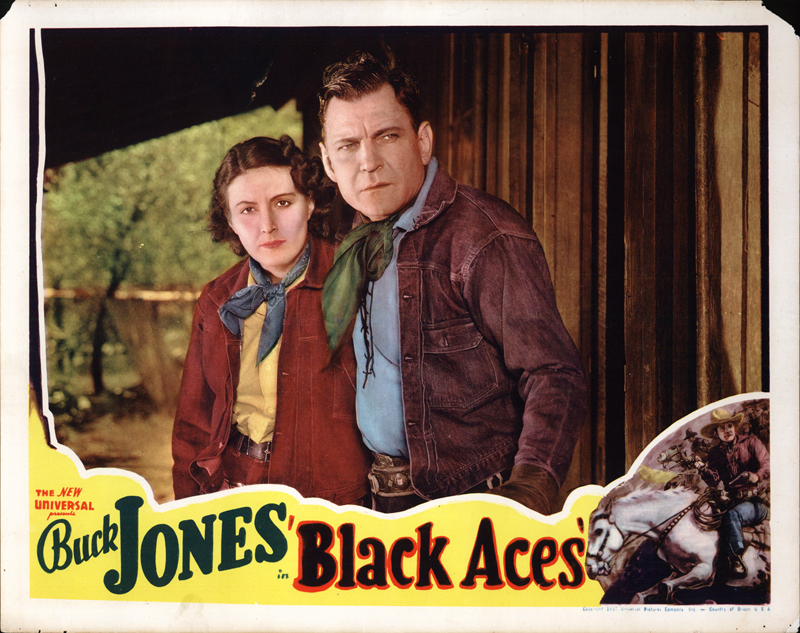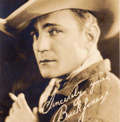|
|
Placerita Canyon

Click image to enlarge Buck Jones and Kay Linaker in front of Frank and Hortese Walker's winter cabin in "Black Aces" (Buck Jones Productions for Universal Pictures, 1937). The cabin is located next to the modern-day parking lot for the Placerita Canyon Nature Center. Original colorized 11x14-inch lobby card reads: "The NEW Universal Presents...," probably a nod to the reorganization of the company. Co-founder Carl Laemmle and son Carl Jr. had been pushed out of management positions the year prior, in 1936, for overspending on production to the point that the company couldn't pay its bills and Standard Capital Corp. foreclosed. Under new management, Universal tightened its belt and focused on low-budget oaters like this one. Released Sept. 5, 1937, "Black Aces" is directed by Jones and also stars Linaker, Robert Frazer, Raymond Brown, Fred MacKaye, Bob Kortman, Frank Campeau, Charles King, Ben Corbett, W.E. Lawrence, Charles Le Moyne, Barney Phillips, Arthur Van Slyke and Robert McKenzie. Jones' horse Silver is credited, too, but the following aren't: Herman Hack, Cliff Lyons (stunts), Billy McClain, Bud McClure, Carlyle Moore Jr., Charles Murphy, Archie Ricks, Jack Shannon and Lee Shumway.
The Life and Untimely Death of Buck Jones. Buck Jones was an A-lister among the "B" Western actors of the 1920s-30s-40s. A popular hero of dime novels and comic books, promoter of Grape-Nuts cereal and Daisy air rifles, Jones frequently starred in films shot at Placerita Canyon and Vasquez Rocks, and he came out of retirement during the war, when younger stars were off serving, to co-star in eight "Rough Riders" buddy pictures for Scott R. Dunlap at Monogram (after Dunlap had made a mid-career move in the 1930s to serve as Jones' business manager). The end of Jones' career didn't come by choice. He died as a result of traumatic burn injuries sustained in the famous Cocoanut Grove fire of Nov. 28, 1942, the deadliest nightclub fire in U.S. history. Flames started downstairs and quickly spread through the Boston nightclub; a single revolving door was the only way out. Jones was counted among the 492 casualties when he died at a hospital two days later. Jones was at the Grove because Dunlap was throwing a party in his honor. Dunlap was seriously injured but survived. Monogram exec Trem Carr was credited (or blamed) for spreading the rumor that Jones sustained his fatal injuries when he rushed back into the burning building to rescue victims, but in fact Jones was trapped behind a wrought-iron railing that incapacitated him in his seat directly across from the bandstand. Born Charles Frederick Gebhart on Dec. 12, 1891, in Vincennes, Ind. — some sources erroneously say Dec. 4, 1889 — he joined the U.S. Army in 1907 at age 16 and earned the Purple Heart during a rebellion in the Philippines. Discharged in 1909, he pursued and interest in auto racing and went to work for Marmon Motor Car Co. He reenlisted in the Army in 1910 and served until 1913, after which he busted broncs on the Miller Bros. 101 Ranch in Oklahoma where he met his bride, Odille "Dell" Osborne. The outbreak of World War I saw him training horses for the allies. Later, a Wild West Show took him to Los Angeles where he got work at Universal as a $5-a-day stuntman and actor. He went to Canyon Pictures and then to Fox Film Corp., earning $40 a week for stunt work. Fox eventually used him as a backup to Tom Mix, raised his salary to $150 a week, and gave him his first starring role in 1920's "The Last Straw." By the mid-1920s he was at least as big a star as Mix, Hoot Gibson or Ken Maynard. In 1928 he formed his own production company, but it was ill-timed. The silent period was closing and Westerns fell into a brief decline; and when the stock market crashed the following year he lost his shirt. He then tried to form his own Wild West show but it, too, failed, and after a year away from the screen, Jones landed at the Poverty Row studio Columbia Pictures at $300 a week, a fraction of his top silent-era salary. (Columbia hadn't yet broken out with 1934's "It Happened One Night.") Westerns roared back in the 1930s and Jones did, too. His masculine voice caught on with audiences as he starred in pictures for Columbia and Universal which were often shot in the Santa Clarita Valley. At one point he received more fan mail than any other actor. The early 1940s saw him co-produce a string of movies with his friend Dunlap, who teamed him up with Tim McCoy and Raymond Hatton to form the Rough Riders. Further reading: Buck Jones, Bona Fide Hero by Joseph G. Rosa, 1966.
LW2516: 19200 dpi jpeg from original lobby card purchased 2013 by Leon Worden. |
Bio/Story 1966
Tobacco Card 1920s
Tobacco Card, Portugese Colonies, 1928
The Avenger 1931
One Man Law 1932
FULL MOVIE
Outlawed Guns 1935
FULL MOVIE+
Stone of Silver Creek 1935 (Mult.)
"Black Aces" 1937
Walker Cabin
Boss of Lonely Valley 1937
Buck Jones Club Badge 1937
Forbidden Trail 1941
FULL MOVIE
Rough Riders 1942
Rough Riders 1942
Down Texas Way 1942
Ghost Town Law 1942 (mult.)
West of the Law 1942
Last Photo 11/28/1942
Dies in Cocoanut Grove Fire
|
The site owner makes no assertions as to ownership of any original copyrights to digitized images. However, these images are intended for Personal or Research use only. Any other kind of use, including but not limited to commercial or scholarly publication in any medium or format, public exhibition, or use online or in a web site, may be subject to additional restrictions including but not limited to the copyrights held by parties other than the site owner. USERS ARE SOLELY RESPONSIBLE for determining the existence of such rights and for obtaining any permissions and/or paying associated fees necessary for the proposed use.




















